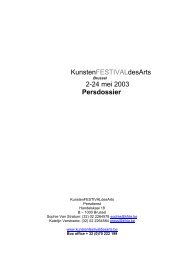Press File - Kunstenfestivaldesarts
Press File - Kunstenfestivaldesarts
Press File - Kunstenfestivaldesarts
Create successful ePaper yourself
Turn your PDF publications into a flip-book with our unique Google optimized e-Paper software.
A simple story. A storyteller-drummer at the court of tyrannical emperor Ts’ao Ts’ao summons<br />
the public and openly insults their supreme leader. Furious, Ts’ao Ts’ao wants to kill the<br />
insolent man but is too cowardly to take charge of it himself. He sends the troubadour to one of<br />
his very quick-tempered subordinates and the outcome is as expected: when the drummer<br />
criticises the irascible courtier he is sent to be executed. Ceremony, Wang Jianwei’s new<br />
theatrical creation, has been inspired by Drum Rolls Criticising Ts’ao. Not without reason.<br />
What is it that initiates a process of creation in you?<br />
I like exploring the flaws in knowledge we have acquired: what they evade, the enigmas of<br />
history. I like questioning what we lose sight of in their many interpretations. I like exploring the<br />
‘intermediate zones’. How different interpretations, perceptions and forms of knowledge can<br />
relate to one other, how they intersect and overlap, and how new realms of potential emerge<br />
which have so far been ignored.<br />
To do this you get your inspiration from texts that already exist. How do you choose<br />
them?<br />
I work with plays and fragments of literature. Both Ping Feng (performed at the<br />
KunstenFESTIVALdesArts 2000, ed.) and Ceremony come from known gems of Chinese art<br />
and literature. Ping Feng was inspired by a scroll of silk painted more than 1,000 years ago by a<br />
painter at the imperial court, Gu Hongzhong. He had been appointed by the emperor to spy on<br />
a high-ranking civil servant he was suspicious of and to report on him. Gu Hongzhong did this<br />
by painting what he had observed. With time the painting Han Xizai gives a Banquet has<br />
become one of the undisputed masterpieces in the history of Chinese painting, and today has<br />
pride of place in the Museum of the Forbidden City. Ceremony was also inspired by the famous<br />
public accusation Drum Rolls Criticising Ts’ao. I’m not interested in reproducing a story from<br />
history or bringing a new aesthetic experience to the stage. I want to ‘read’ history and<br />
understand the manner and details of how the different interpretations of it influence our<br />
experiences of life and our attitude towards it, our individual and collective consciousness.<br />
Who was Ts’ao?<br />
Ts’ao Ts’ao, (155-220 A.D.) is a particularly significant figure in the history of China. Under the<br />
Han dynasty, one of the most turbulent periods in Chinese history, several nobles were fighting<br />
for power and had sown division in the country. Ts’ao Ts’ao succeeded in dominating and<br />
unifying the provinces in the north. To do this he abused his position as prime minister whilst<br />
feigning respect for the emperor who was nothing more than a puppet. When Ts’ao Ts’ao died,<br />
his son followed in his footsteps and took over the imperial throne. Already at that time Chinese<br />
opinion was criticising his character and the way he acted, taking a swipe at him as an example<br />
of the ancient proverb: “He who usurps a title will never keep his word.”<br />
Drum Rolls Criticising Ts’ao seizes on Ts’ao Ts’ao as a classic example of a treacherous<br />
courtier. The story is based on three different literary texts about the same subject, spread out<br />
over 1,000 years: The History of Han, Romance of Three Kingdoms and a traditional text<br />
entitled Kuang Gu Shi Yu Yang San Nong. The writers and styles are very varied – the first text<br />
is from the annals of a court chronicler, the second text is a story passed down orally from<br />
generation to generation and the third is a traditional play. So there are three interpretations.<br />
Where does the title Ceremony come from?<br />
The title of Ceremony has a double meaning. On the one hand all three literary sources I’ve<br />
used mention a place where people gathered together: the ceremony of the drum. This unusual<br />
place suggests in advance that we’ll be dealing with a character out of the ordinary. On the<br />
other hand the story has a ceremonial nature. It is based on historic texts covering over one<br />
thousand years of history. During this period the sustained repetition of this story has resulted in<br />
a consolidation of an uncontestable historical image. Serving as a norm, this story became<br />
embedded in the collective memory. These two types of ceremony merge together and so<br />
describe an irrefutable ‘historical event’.<br />
32






